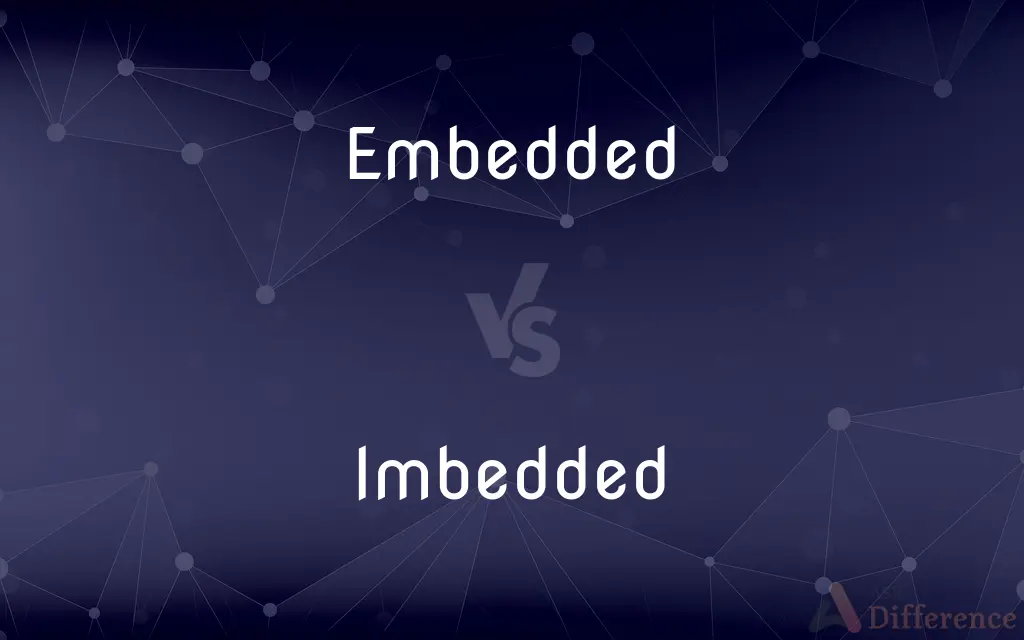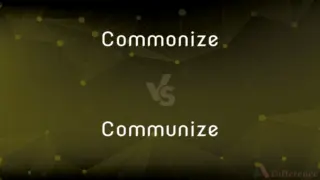Embedded vs. Imbedded — What's the Difference?
By Maham Liaqat & Urooj Arif — Updated on February 22, 2024
"Embedded" and "imbedded" refers to the act of fixing something firmly and deeply within a surrounding mass. "Embedded" is the more commonly used term, especially in technical and journalistic contexts, whereas "imbedded" is less common.

Difference Between Embedded and Imbedded
Table of Contents
ADVERTISEMENT
Key Differences
"Embedded" is widely used in various fields, including technology, where it describes components such as software or systems that are an integral part of a larger system or device. For example, embedded systems in electronics are designed to perform dedicated functions within larger devices, like the control system in a washing machine. In journalism, an "embedded journalist" travels with military units to provide close-up reporting from the field.
"Imbedded," while technically correct, is less frequently used in contemporary language. It carries the same meaning as "embedded" and can be found in certain texts or contexts, possibly for stylistic reasons or in older literature. The choice between "embedded" and "imbedded" often comes down to regional preferences, the tradition of specific disciplines, or the desired tone of the communication.
In engineering and computing, "embedded" is the standard term, particularly when referring to embedded systems or embedded software, indicating that the item is an integral part of the larger system and is designed to perform specific, limited functions.
In general usage, "embedded" implies integration or enclosure within a distinct context, such as "embedded reporters" in military units, "embedded videos" in web pages, or "embedded rocks" in concrete. The term suggests a deep integration that makes the embedded item a fundamental component of the whole.
Understanding the slight distinction between "embedded" and "imbedded" is important for clear communication, especially in professional and technical writing where precision is key. While "embedded" is the preferred choice in most modern and technical contexts, recognizing "imbedded" as a variant helps in comprehending diverse texts and historical literature without confusion.
ADVERTISEMENT
Comparison Chart
Usage Frequency
More commonly used, especially in technical and journalistic contexts.
Less common, considered an archaic or alternate form.
Fields of Use
Technology, journalism, military, and more.
Used interchangeably with "embedded" but less prevalent.
Implication
Suggests deep integration or enclosure within a distinct context.
Same as "embedded," but less commonly employed.
Examples
Embedded systems, embedded journalists.
Can be used similarly, e.g., imbedded stones in a wall, but less frequent.
Preference
Preferred in modern English, especially in professional and technical communication.
Might be used for stylistic reasons or in older literature, but generally less favored.
Compare with Definitions
Embedded
Integrated deeply within a system.
The spy was embedded within the enemy's ranks for months.
Imbedded
Alternate form meaning deeply integrated.
The fossil was imbedded in the limestone for millions of years.
Embedded
Part of a larger whole.
The embedded software controls the device's main functions.
Imbedded
Less common spelling for fixed firmly.
The jewels were imbedded into the crown with great care.
Embedded
Making an integral component.
The video was embedded directly into the webpage.
Imbedded
Can be used interchangeably with "embedded."
Imbedded technology in modern appliances enhances functionality.
Embedded
Firmly fixed in a surrounding mass.
The artifact was embedded in the rock, making extraction difficult.
Imbedded
Found in certain texts or older literature.
The sword was imbedded in stone, awaiting its rightful heir.
Embedded
Enclosed within another context.
The journalist was embedded with the troops during the conflict.
Imbedded
Sometimes preferred for stylistic or regional reasons.
The artist's signature was imbedded discreetly in the corner.
Embedded
To become embedded.
The harpoon struck but did not embed.
Imbedded
One that is embedded, especially a journalist who is assigned to an active military unit.
Embedded
To fix firmly in a surrounding mass.
Embed a post in concrete.
Fossils embedded in shale.
Imbedded
Variant of embed.
Common Curiosities
Are there contexts where "imbedded" is more appropriate?
"Imbedded" might be chosen for stylistic reasons, in poetic or literary texts, or in regions where this form has traditionally been more common.
Why is "embedded" more common than "imbedded"?
"Embedded" has become the standard form in modern English, particularly in technical and journalistic contexts, making it more widely accepted and used.
How does one decide whether to use "embedded" or "imbedded"?
The choice often depends on the context, audience, and regional or stylistic preferences, though "embedded" is generally the safer and more widely accepted option.
How does the use of "embedded" in technology differ from general use?
In technology, "embedded" specifically refers to components or systems that are an integral part of a larger device, designed to perform dedicated functions, whereas in general use, it simply means something is deeply integrated or fixed within something else.
What is an "embedded journalist"?
An embedded journalist is a reporter who is attached to a military unit during conflicts or operations to provide close-up, in-depth reporting from the field.
Can "embedded" and "imbedded" be used interchangeably?
Yes, in most contexts, they can be used interchangeably, though "embedded" is preferred, especially in technical language.
Can "embedded" refer to digital content?
Yes, "embedded" can refer to digital content, such as videos or maps, that is integrated into a webpage or software application.
Is "imbedded" incorrect?
No, "imbedded" is not incorrect, but it's an alternate, less common form of "embedded."
Is the preference for "embedded" over "imbedded" a recent change?
The preference for "embedded" has solidified over time, particularly with the rise of technology and specialized fields where "embedded" is the standard term.
Are there any specific rules for using "embedded" in technical writing?
In technical writing, clarity and precision are paramount, so "embedded" is preferred to describe components or systems that are part of a larger device or structure, aligning with the term's widespread acceptance in technical fields.
Share Your Discovery

Previous Comparison
Tart vs. Torte
Next Comparison
Commonize vs. CommunizeAuthor Spotlight
Written by
Maham LiaqatCo-written by
Urooj ArifUrooj is a skilled content writer at Ask Difference, known for her exceptional ability to simplify complex topics into engaging and informative content. With a passion for research and a flair for clear, concise writing, she consistently delivers articles that resonate with our diverse audience.














































